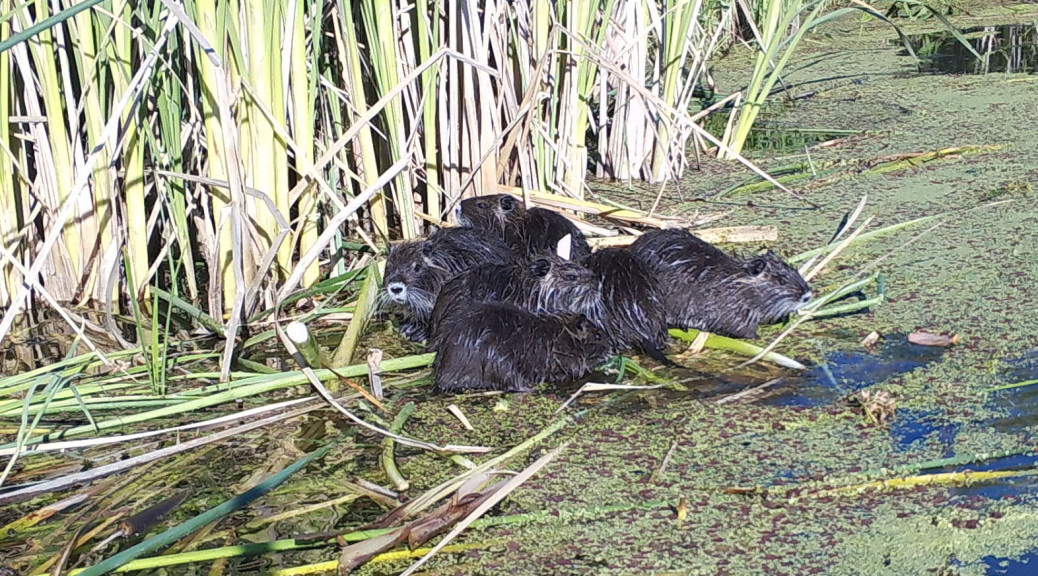
Credit: CDFW
March 26, 2019 - One year after launching an Incident Command System and a formal effort to eradicate invasive nutria from the state, the California Department of Fish and Wildlife (CDFW) reports significant progress in combatting the destructive, South American rodents, though much work remains.
In the early 1900s, nutria were imported and farmed in California for the fur trade. Following the market collapse, escaped and released nutria established small populations that were eventually eradicated by the late 1970s. In 2017, nutria were again discovered within the San Joaquin Valley.
Nutria pose a “triple threat” to California’s future as a top-rated agricultural pest, a destroyer of critical wetlands needed by native wildlife, and a public safety risk as their destructive burrowing jeopardizes the state’s water delivery and flood control infrastructure. CDFW has formed partnerships with both the U.S. Department of Agriculture and the California Department of Food and Agriculture to survey and eradicate nutria from the state.
To date:
- CDFW and USDA have taken or confirmed the take of 410 nutria in five counties – 330 from Merced County, 65 from San Joaquin County, 12 from Stanislaus County, two from Mariposa County and one from Fresno County. Nutria have also been confirmed in Tuolumne County.
- The eradication efforts have prioritized the one known nutria population in the Sacramento-San Joaquin Delta in order to limit their spread and impact on California’s most important water resource and the heart of the state’s water delivery and infrastructure. Of the 65 nutria taken from San Joaquin County, 64 were captured within Walthall Slough near Manteca. Survey crews have not detected nutria elsewhere in the Sacramento-San Joaquin Delta.
- Nutria are a semi-aquatic species never far from water. CDFW has identified approximately 1.8 million acres of habitat suitable for nutria in California, mostly in the state’s central regions. CDFW so far has assessed more than 300,000 acres in three counties: Merced, Stanislaus and San Joaquin.
- In suitable nutria habitat, CDFW and its partners set up trail cameras to monitor for nutria presence and deploy traps to catch the nutria once their presence has been confirmed. Over the past year, the project has set up 487 camera stations, conducted more than 1,600 camera checks and deployed 995 trap sets for a total of 12,930 trap nights.
- CDFW’s eradication efforts have the broad support of the state’s agricultural community. As a top-rated agricultural pest, nutria threaten California’s nearly $50 billion agricultural industry. San Joaquin Valley farmers have donated five tons of sweet potatoes to use as bait to trap nutria.
- Nutria have been documented on federal, state and private property. Gaining access to private property is key to eradication efforts and to prevent isolated populations from re-infesting the state. More than 2,400 private property owners have granted CDFW written permission to survey and trap nutria on their land, which CDFW does at no cost to property owners.
- CDFW has received widespread public support for its eradication efforts. CDFW’s Invasive Species “hotline” and corresponding e-mail account has received 357 nutria reports from the public over the past year. While most of these have turned out to be false reports – either sightings of other wildlife mistaken for nutria or reports that lack enough information to confirm – public reporting will continue to be important to determine the full extent of the infestation. When possible, reports should be accompanied by photos and videos. CDFW’s toll-free reporting hotline is (866) 440-9530. The e-mail address to report nutria sightings is invasives@wildlife.ca.gov. CDFW’s nutria eradication webpage at wildlife.ca.gov/nutria offers references for distinguishing nutria from other similar aquatic animals.
- Public education and outreach are key components of CDFW’s eradication efforts. In addition to numerous nutria presentations in front of scientific, agricultural and community organizations, CDFW has partnered with the Delta Stewardship Council to produce a nutria identification pocket guide. The guide is available at http://deltacouncil.ca.gov/nutria-pocket-guide.
- CDFW has secured more than $3 million in state and federal grants to support nutria eradication. The Sacramento-San Joaquin Delta Conservancy has awarded CDFW $1.2 million over three years; California’s Wildlife Conservation Board has awarded CDFW $600,000 over three years; and the U.S. Fish and Wildlife Service’s State Wildlife Grant Program has awarded CDFW $1.25 million over three years.
- Future CDFW nutria efforts include using detection dogs to help locate remnant nutria or confirm their absence. CDFW also is in the early stages of developing a “Judas nutria” project where surgically sterilized nutria, which are social animals, are outfitted with radio telemetry collars and released back into the environment to lead biologists to other nutria.
- CDFW’s eradication efforts are modeled after those in the Chesapeake Bay in the 2000s. That ongoing effort is led by the federal government and has removed more than 14,000 nutria from 250,000 acres in the Delmarva Peninsula. Though nutria are established in more than a dozen U.S. states, including Washington, Oregon, and, most notably, Louisiana, the Chesapeake Bay effort remains the only successful, large-scale nutria eradication in U.S. history.
Source: CDFW








